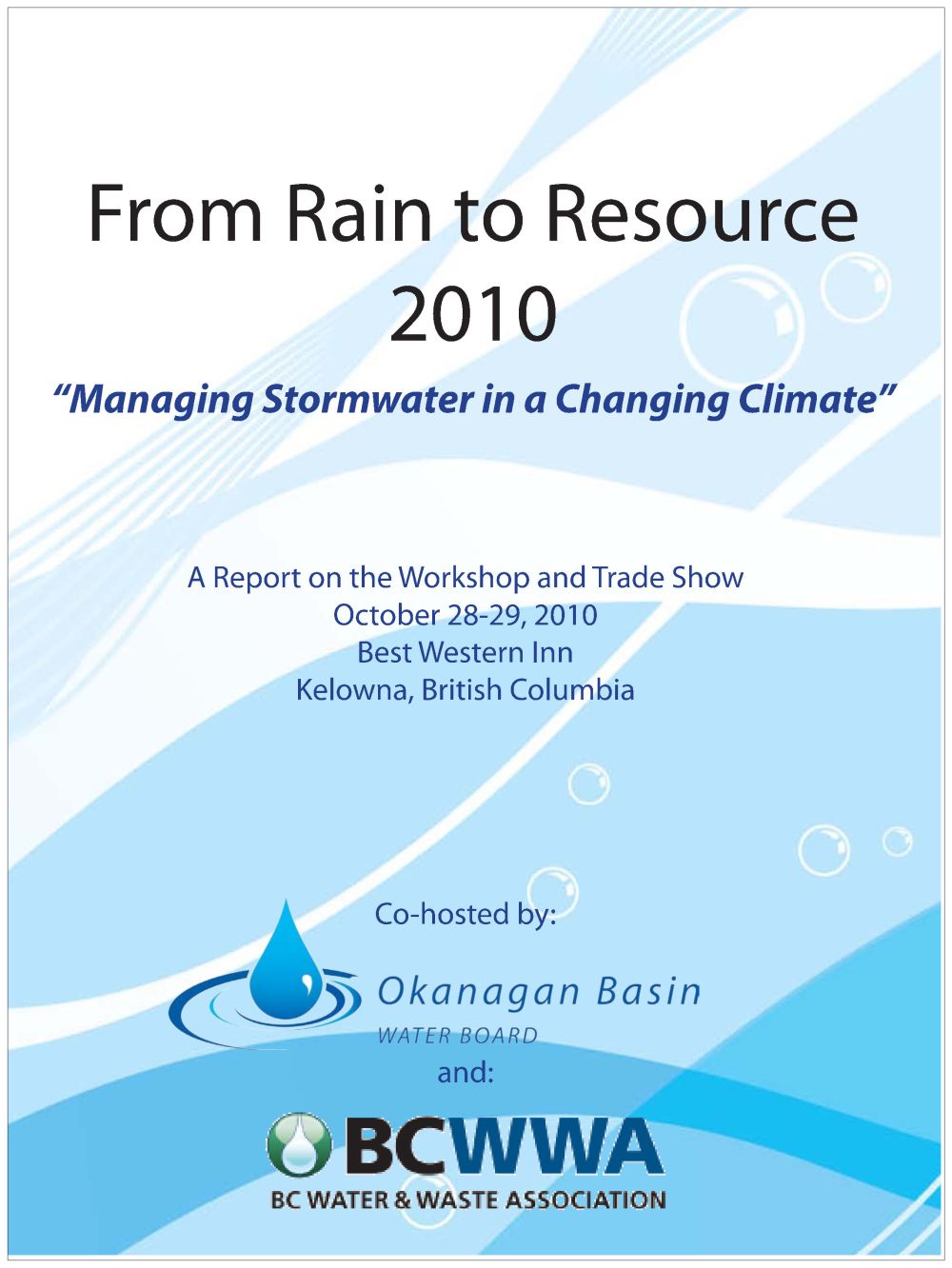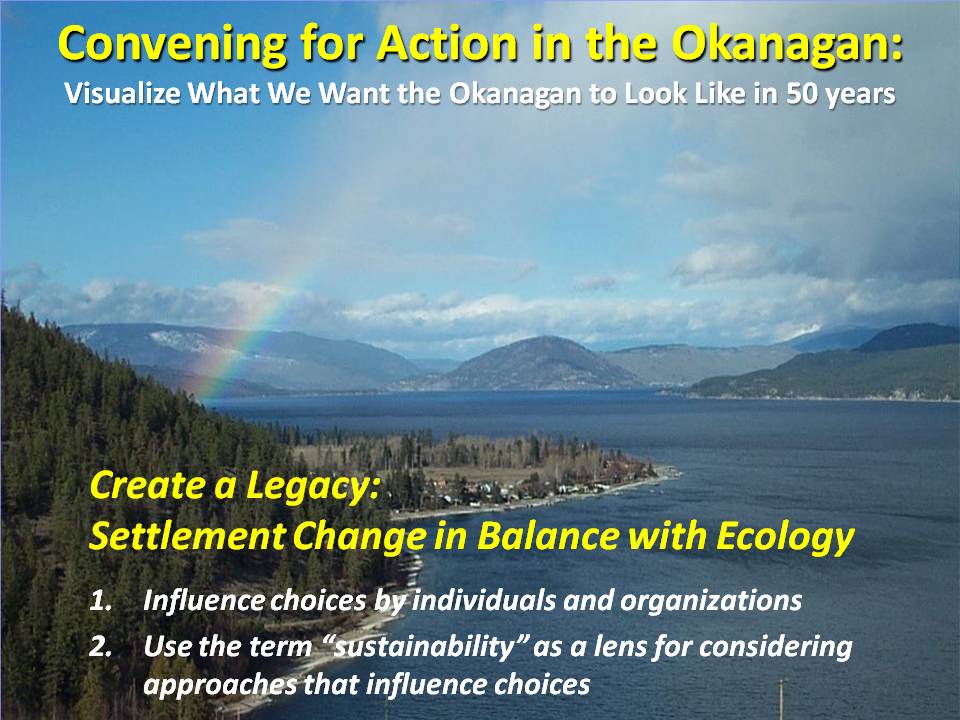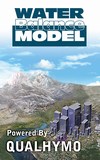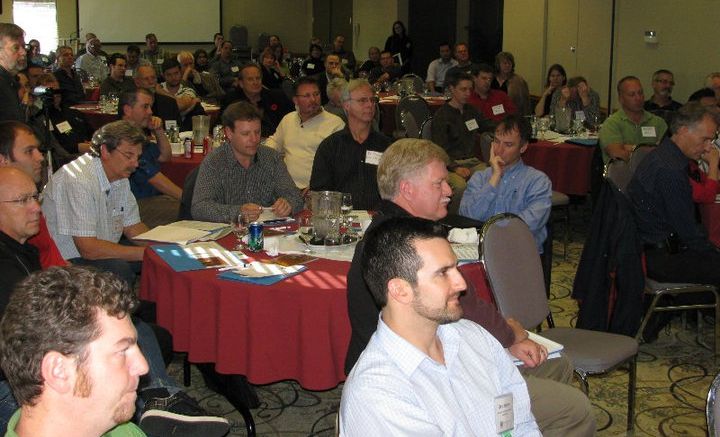FROM RAIN TO RESOURCE WORKSHOP: Okanagan Basin Water Board releases report on ‘Managing Stormwater in a Changing Climate’ (February 2011)
Note to Reader:
In October 2010, the 2-day From Rain to Resource Workshop: Managing Stormwater in a Changing Climate brought together twenty-two expert speakers and panellists and more than 100 delegates from across British Columbia. Delegates included mayors and councillors, administrative staff, planners, engineers and consultants from around the province.
Held in Kelowna, the event was presented by the Okanagan Basin Water Board (OBWB) in partnership with the BC Water and Waste Association (BCWWA) and with funding support through Natural Resources Canada’s Regional Adaptation Collaboratives Program (RAC).
In February 2011, the OBWB released a report that summarizes a comprehensive set of recommendations that came out of the workshop. The report also provides an overview of the topics and case studies that were presented. To download a copy, click on From Rain to Resource 2010: Managing Stormwater in a Changing Climate.
The following article highlights key findings from the report, with emphasis on the recommendation that local governments incorporate the Water Balance Model into watershed planning. To download a PDF version of this article, click here.

Convening for Action in the Okanagan
 “Extreme weather patterns, including higher rainfall intensities and more frequent flooding, are one of the projected outcomes of climate change. Managing stormwater effectively will be a critical climate change adaptation tool,” stated Anna Warwick Sears, Executive Director of the Okanagan Basin Water Board.
“Extreme weather patterns, including higher rainfall intensities and more frequent flooding, are one of the projected outcomes of climate change. Managing stormwater effectively will be a critical climate change adaptation tool,” stated Anna Warwick Sears, Executive Director of the Okanagan Basin Water Board.
“A key component of managing for storms is redesigning our approach to handling the more frequent, lighter rainfall events. Rainwater management keeps water on-site, improving water quality by reducing runoff pollution, allowing the rain to infiltrate and recharge aquifers, and establishing ways to harvest water for other uses. Rainwater management complements management of larger storm events, and reduces infrastructure requirements overall.”
 “The Rain to Resource workshop brought together a wide cross-section of interested and knowledgeable individuals and provided an opportunity for them to share their knowledge and experiences. BCWWA was pleased to partner with the OBWB in this initiative and commends the OBWB for preparing the summary report and documenting the learnings that took place,” added Daisy Foster, BCWWA Chief Executive Officer.
“The Rain to Resource workshop brought together a wide cross-section of interested and knowledgeable individuals and provided an opportunity for them to share their knowledge and experiences. BCWWA was pleased to partner with the OBWB in this initiative and commends the OBWB for preparing the summary report and documenting the learnings that took place,” added Daisy Foster, BCWWA Chief Executive Officer.
Why ‘From Rain to Resource 2010’?
“We spent the last half a century trying to control runoff with dikes, storm sewers, curbs and gutters. Now, increased development and increased storm intensity from climate change are increasing peak flows and altering the rules of the game. We can’t engineer away our problems fast enough, and have to look at other, lower impact solutions,” continued Anna Warwick Sears in providing context for the OBWB decision to organize From Rain to Resource 2010.
“The Okanagan is particularly vulnerable to the impacts of unmanaged stormwater and rainwater because all surface water flows into the lake system that runs along the bottom of the valley—and that lake is a primary drinking water source.”
“Many positive and innovative developments in rainwater and stormwater management have not yet been introduced in Okanagan municipalities and rural areas. This workshop was held to highlight the importance of rainwater management to climate change adaptation and to showcase examples from other areas that could be applied to the Okanagan.”
Overview of Workshop Outcomes
The workshop provided a unique opportunity for municipal engineers and planners and elected leaders to participate in a shared learning experience. The workshop format and content was designed to facilitate a common understanding between technical and policy people of the issues and solutions around rainwater management.
The speakers provided many practical examples of innovative rainwater and stormwater management techniques that could be implemented in the Okanagan. Integrating the low-impact rainwater management techniques presented at the From Rain to Resource workshop will reduce infrastructure costs and environmental problems in the future.
The presentations covered climate change adaptation, watershed planning, site-level rainwater management and policies and tools for rainwater management. Each presentation included one or more case studies to illustrate the effectiveness of the technique(s), principles, or standards presented.
To Learn More:
 A set of concrete recommendations for all levels of government were gathered from the workshop. Sixteen recommendations were organized under five categories. The complete set of resources is posted on the OBWB website. These resources include video clips of the keynote presentation by Brock Dolman, Director of the California-based WATER Institute. He introduced the BC audience to the concept of Conservation Hydrology when he spoke to Basins of Relations: Thinking Like a Watershed.
A set of concrete recommendations for all levels of government were gathered from the workshop. Sixteen recommendations were organized under five categories. The complete set of resources is posted on the OBWB website. These resources include video clips of the keynote presentation by Brock Dolman, Director of the California-based WATER Institute. He introduced the BC audience to the concept of Conservation Hydrology when he spoke to Basins of Relations: Thinking Like a Watershed.

Rain to Resource Workshop Showcased
‘Beyond the Guidebook 2010’
The majority of the workshop presentations were delivered by members of the “convening for action” partnership network, and were about case studies that are featured in Beyond the Guidebook 2010, in particular:
- the experiences of these ‘convening for action’ partners: City of Surrey, District of North Vancouver, City of Courtenay, Capital Regional District, Metro Vancouver; and
- these tools and resources: the Water Balance Model, the Topsoil Primer Set.
These “convening for action” case studies were supplemented by several other examples of innovative approaches to rainwater management, including presentations about experience in the BC Interior (e.g. City of Prince George) and within the Capital Region (Douglas Creek Watershed).
Recommendations for Local Government
The recommendations contained in the From Rain to Resource 2010 report are based on presentations, the panel discussion, and audience questions and comments at the workshop. The seven recommendations for local government are listed below:
- Use Low Impact Development Techniques in Your Community
- Assess Stormwater Risks and Watershed Vulnerability in Your Community
- Incorporate the Water Balance Model into Planning
- Focus on Watershed Targets and Outcomes
- Consider the Site
- Share Responsibility and Collaborate
- Be Innovative and Learn from the Experiences of Others
 In her welcoming remarks at the workshop, Kelowna Mayor Sharon Shepherd connected the “convening for action” dots to Beyond the Guidebook 2010. “In 2006 I was a member of a Mayors and Chairs Focus Group that yielded insights regarding how to lead and implement green infrastructure changes. Also, Kelowna was one of four cities – the others being Chilliwack, Surrey and Courtenay – that were early adopters of the Water Balance Model. Beyond the Guidebook 2010 was an outcome of this related initiatives. The Water Balance Model tool is extremely helpful as we all look at the process for developing urban watershed plans that are outcome-oriented.”
In her welcoming remarks at the workshop, Kelowna Mayor Sharon Shepherd connected the “convening for action” dots to Beyond the Guidebook 2010. “In 2006 I was a member of a Mayors and Chairs Focus Group that yielded insights regarding how to lead and implement green infrastructure changes. Also, Kelowna was one of four cities – the others being Chilliwack, Surrey and Courtenay – that were early adopters of the Water Balance Model. Beyond the Guidebook 2010 was an outcome of this related initiatives. The Water Balance Model tool is extremely helpful as we all look at the process for developing urban watershed plans that are outcome-oriented.”
To Learn More:
The City of Kelowna played a key role in proving out the methodology that underpins the Water Balance Model. To read a story that elaborates on the City’s contribution to a science-based approach, click on Water Balance Model Retrospective: A Decade Ago, City of Kelowna Case Study Validated the Methodology for Interior BC Conditions.
Application of the Water Balance Model
Released in June 2010, Beyond the Guidebook 2010: Implementing a New Culture for Urban Watershed Protection and Restoration in British Columbia demonstrates that the practitioner culture is changing as an outcome of collaboration, partnerships and alignment.
 “Building on case study experience, Beyond the Guidebook 2010 provides local governments with ‘how to’ guidance for developing outcome-oriented urban watershed plans. The foundation for ‘RAINwater management’ is the ‘runoff-based’ approach to establishing targets for rainfall capture at a watershed scale,” reported Kim Stephens, Executive Director of the Partnership for Water Sustainability in British Columbia and editor of Beyond the Guidebook 2010.
“Building on case study experience, Beyond the Guidebook 2010 provides local governments with ‘how to’ guidance for developing outcome-oriented urban watershed plans. The foundation for ‘RAINwater management’ is the ‘runoff-based’ approach to establishing targets for rainfall capture at a watershed scale,” reported Kim Stephens, Executive Director of the Partnership for Water Sustainability in British Columbia and editor of Beyond the Guidebook 2010.
“Keyed to the estimation of the amount of water in the stream over a long period of time, the ‘runoff-based’ approach connects these dots: impacts to a stream; the causes in the urban landscape; and the mitigation methods needed to restore the natural water balance in the stream.”
“The runoff-based Water Balance Model is a tool to assess green infrastructure effectiveness in protecting stream health. The user can correlate runoff volume management strategies with stream erosion and water quality outcomes. This process allows the delivery of watershed-specific and outcome-oriented plans that are specifically applicable to the municipality, watershed and stream,” concludes Kim Stephens.
To Learn More:
To access the Homepage for Beyond the Guidebook 2010, click here. A set of 39 stories comprise extracts from this guidance document; and showcase case studies that influenced the recommendations in the From Rain to Resource 2010 report.



